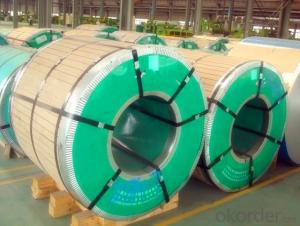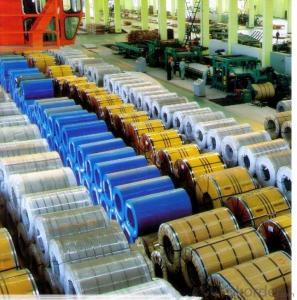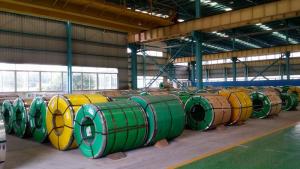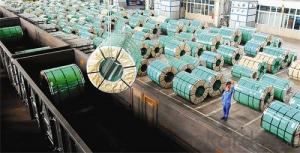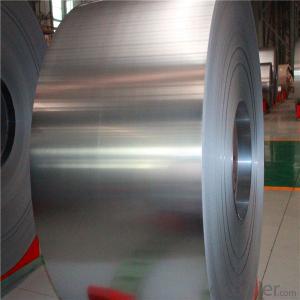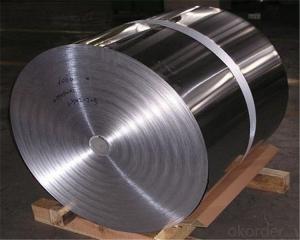Stainless Steel Coil 304 Cold Rolled 2B Narrow
- Loading Port:
- Ningbo
- Payment Terms:
- TT OR LC
- Min Order Qty:
- 100 m.t.
- Supply Capability:
- 20000 m.t./month
OKorder Service Pledge
OKorder Financial Service
You Might Also Like
Cold Rolled Stainless Steel Coil 304 Grade Narrow/Wide 2B/BA Finish
Packaging Detail: standard export packing or as customer's requirements
Delivery Detail: 7-15 days after the order
Standard: | AISI,ASTM,BS,DIN,GB,JIS | Grade: | 304 | Thickness: | 0.3-3.0mm |
Place of Origin: | China Mainland | Brand Name: | CNBM | Model Number: | 304 |
Type: | Steel Coil | Technique: | Cold Rolled | Surface Treatment: | 2B, BA |
Application: | Medical instruments, building, chemical food industry agriculture | Width: | 500-2000mm | Length: | Coil |
finish: | 2B, BA | item: | 304 cold rolled stainless steel coil | density: | 7.93 |
- Q: What is the fracture toughness of stainless steel strips?
- The fracture toughness of stainless steel strips can vary depending on the specific grade and composition of the stainless steel. Generally, stainless steel has high fracture toughness due to its excellent resistance to cracking and ability to absorb energy before fracturing.
- Q: Can stainless steel strips be used in conveyor systems?
- Yes, stainless steel strips can be used in conveyor systems. Stainless steel is known for its durability, corrosion resistance, and high strength, making it suitable for conveying various materials in industries such as food processing, manufacturing, and mining. Stainless steel strips can withstand heavy loads and harsh environments, making them an ideal choice for conveyor applications.
- Q: What is the maximum temperature resistance of stainless steel strips?
- The maximum temperature resistance of stainless steel strips largely depends on the specific grade of stainless steel being used. However, in general, stainless steel has excellent heat resistance properties and can withstand high temperatures without significant deformation or loss of strength. Most standard stainless steel grades, such as 304 and 316, can typically withstand temperatures up to 1500°F (815°C) without any major issues. However, there are certain specialized stainless steel grades, such as 310 and 330, which offer even higher temperature resistance, reaching up to 2100°F (1150°C) and 2200°F (1200°C) respectively. It is important to note that the maximum temperature resistance of stainless steel can also be influenced by factors such as exposure time, the presence of corrosive agents, and the specific application. Therefore, it is always recommended to consult with the manufacturer or a material specialist to determine the maximum temperature resistance of stainless steel strips for a specific application or environment.
- Q: Can stainless steel strips be used in household appliances?
- Household appliances can indeed utilize stainless steel strips. The exceptional resistance to corrosion, durability, and appealing appearance make stainless steel a popular choice in appliance manufacturing. It is common to find stainless steel strips incorporated into different parts of household appliances like refrigerators, dishwashers, ovens, and stovetops. These strips often contribute to the construction of appliance doors, handles, control panels, and trims. By employing stainless steel strips, appliances acquire a contemporary and polished appearance while also possessing the necessary strength and resilience to endure the rigors of daily use in a household environment.
- Q: Can stainless steel strips be used in transportation applications?
- Yes, stainless steel strips can certainly be used in transportation applications. Stainless steel is known for its high strength and durability, which makes it suitable for various transportation components. It is commonly used in the automotive industry for manufacturing parts such as exhaust systems, body panels, and trim. Stainless steel strips are also used in the aerospace industry to make aircraft components, including frames, brackets, and fittings. Additionally, stainless steel's resistance to corrosion and oxidation makes it ideal for marine transportation applications, such as boat building and shipbuilding. Overall, stainless steel strips are versatile and reliable materials for transportation applications due to their strength, durability, and resistance to environmental factors.
- Q: How do stainless steel strips resist chemical exposure?
- Due to their unique composition and properties, stainless steel strips possess remarkable resistance against chemical exposure. Mainly comprised of iron, chromium, and other alloying elements like nickel and molybdenum, stainless steel forms a protective layer of chromium oxide on its surface. This chromium oxide layer acts as a barrier, effectively shielding the metal from chemical attack and preventing corrosion. The stability of this chromium oxide layer is exceptional, ensuring that the underlying metal remains unaffected by chemicals and corrosion. The self-healing and passive nature of stainless steel is what enables it to exhibit excellent resistance against a wide array of chemicals, including acids, alkalis, and corrosive substances. Furthermore, the chemical resistance of stainless steel strips can be further improved by modifying their composition or incorporating specific alloying elements. For instance, increasing the amount of nickel can bolster resistance against certain acids, while the addition of molybdenum can enhance resistance in chloride-containing environments. Moreover, the chemical resistance of stainless steel strips can be augmented through various surface treatments and coatings. These treatments encompass passivation, electropolishing, and the application of specialized coatings that offer enhanced protection against chemical exposure. In conclusion, the exceptional resistance to chemical exposure exhibited by stainless steel strips is a result of their inherent composition and the ability to customize their properties. This makes them highly suitable for a wide range of applications in industries such as chemical processing, pharmaceuticals, food processing, and more.
- Q: How does the price of stainless steel strips compare to other materials?
- The price of stainless steel strips can vary depending on the specific grade and size of the strip, as well as current market conditions. However, in general, stainless steel strips tend to be more expensive compared to other materials. This is primarily due to the higher cost of production and the unique properties of stainless steel. Stainless steel is known for its exceptional corrosion resistance, durability, and strength. It is also highly resistant to heat and physical damage, making it suitable for a wide range of applications in various industries. These superior properties contribute to the higher price of stainless steel strips compared to other materials. In contrast, materials like carbon steel or aluminum are generally more affordable. Carbon steel strips are widely used due to their lower production costs and satisfactory strength properties. Aluminum strips, on the other hand, are lightweight and have good corrosion resistance, but they are less strong and durable than stainless steel. When considering the price of stainless steel strips, it is important to evaluate the specific requirements of the intended application. While stainless steel may be more expensive upfront, its long-term benefits, such as extended lifespan and reduced maintenance costs, can make it a more cost-effective choice in many cases. Ultimately, the price of stainless steel strips is influenced by numerous factors, including market demand, availability of raw materials, and manufacturing processes. It is advisable to consult with suppliers or industry experts to obtain accurate and up-to-date pricing information for stainless steel strips and compare it with other materials to make an informed decision.
- Q: Are stainless steel strips suitable for architectural mesh applications?
- Yes, stainless steel strips are suitable for architectural mesh applications. Stainless steel is a durable and corrosion-resistant material, making it perfect for outdoor or high-traffic areas. It offers excellent strength and stability while also allowing for flexibility in design and installation. Additionally, stainless steel mesh can provide security and privacy while still allowing for airflow and visibility. With its aesthetic appeal and functionality, stainless steel strips are an ideal choice for architectural mesh applications.
- Q: How do stainless steel strips perform in seawater environments?
- Stainless steel strips are highly resistant to corrosion and perform exceptionally well in seawater environments. Due to their composition, which includes a significant amount of chromium, stainless steel strips form a passive oxide layer on their surface that acts as a protective barrier against corrosion. This oxide layer prevents direct contact between the steel and the corrosive elements present in seawater, such as salt and moisture. Furthermore, stainless steel strips exhibit excellent resistance to pitting and crevice corrosion, which are common forms of corrosion in marine environments. This resistance is primarily attributed to the high levels of chromium and nickel present in stainless steel. These elements enhance the steel's ability to withstand the aggressive nature of seawater, ensuring its durability and longevity. Stainless steel strips also have the advantage of being highly versatile and adaptable, making them suitable for various applications in seawater environments. They can be easily formed, welded, and fabricated into different shapes and sizes, providing flexibility in design and construction. Overall, stainless steel strips are an excellent choice for use in seawater environments due to their exceptional corrosion resistance, durability, and versatility. They offer long-lasting performance, minimal maintenance requirements, and can withstand the harsh conditions associated with marine applications, making them a reliable and cost-effective solution.
- Q: Can stainless steel strips be used for decorative screens?
- Yes, stainless steel strips can be used for decorative screens. Stainless steel is a versatile material that offers durability, resistance to corrosion, and a sleek, modern appearance, making it suitable for creating decorative screens in various settings such as homes, offices, or public spaces.
Send your message to us
Stainless Steel Coil 304 Cold Rolled 2B Narrow
- Loading Port:
- Ningbo
- Payment Terms:
- TT OR LC
- Min Order Qty:
- 100 m.t.
- Supply Capability:
- 20000 m.t./month
OKorder Service Pledge
OKorder Financial Service
Similar products
Hot products
Hot Searches
Related keywords
